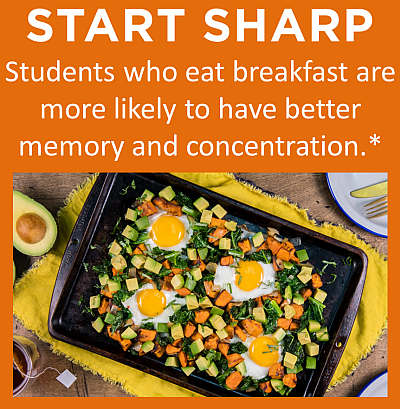Have a feeling your children are forgetting something in the morning? Could it be … breakfast?
Children, teens and young adults skip breakfast more than any other meal. That means they’re starting their day without a fresh source of nourishment—something that shouldn’t wait until lunchtime.
But nutrition isn’t the only thing that falls to the wayside when breakfast falls off the morning schedule. For K-12 students in particular, the AM meal is critical for fueling success in the classroom. Without it, they can’t bring their best to the school day.

To mark National School Breakfast Week, we’re digging deeper with Gay Anderson, School Nutrition Specialist and President of the School Nutrition Association. She’s here to answer three key questions—and help make breakfast part of your family’s daily routine.
WHY IS BREAKFAST SO IMPORTANT FOR CHILDREN?
Our experts shared why breakfast is important from a nutritional standpoint in a previous blog. Below Gay shares a refresher on why the first meal of the day is critical for proper nutrition and elaborates on how it can benefit children in the classroom.

- It gives them a head-start on nutrition. “Breakfast is a great chance to give your children fiber, protein, calcium, and other nutrients,” she explains. “Skipping breakfast simply puts more pressure on lunch and dinner—which may not meet their daily nutrition needs completely.”
- It helps their brains work better. Children who eat breakfast are more likely to be able to pay attention in class and tend to have stronger memories—both of which can lead to better performance. “Eating breakfast can make a significant difference in math, reading, and standardized test scores,” says Gay. “On the other hand, research shows that starting school on an empty stomach has a negative impact on academic performance.”
- It can boost their mood. Skipping breakfast can make children feel tired, restless, or irritable. Healthy food in the morning gives them energy to face the day. Gay reminds us that “students who act out in school may actually just be hungry.”
- It can help them maintain a healthy weight. “Breakfast jumpstarts the body’s metabolism, and children who eat breakfast regularly are less likely to be overweight,” explains Gay. Think of breakfast as one of many lifelong habits to instill in your children.
WHAT DOES A HEALTHY BREAKFAST LOOK LIKE?
“A breakfast with the right combination of carbohydrate, protein, and healthy fat will help your children reap the most benefit and feel full for hours. This is true of any meal, but extra-important in the morning,” says Gay.
To build your balanced breakfast, choose from at least three of the following food groups.
| FOOD GROUP | A FEW FAVORITES | RECIPES TO TRY |
| Whole Grains | Oats, Whole-wheat bread |
Quaker Best Banana Bread Strawberry Chia Toast |
| Fruits and Vegetables | Strawberries, Spinach |
Avocado Berry Breakfast Smoothie Egg White Flatbread with Spinach Feta Spread |
| Dairy | Low-fat or fat-free milk, Cottage cheese |
Breakfast Berries and Chia Seed Parfait Blueberry Cottage Cheese Pancakes |
| Protein | Eggs, Peanut butter |
Sheet Pan Breakfast With Avocados Peanut Butter Power Toast |
HOW CAN PARENTS ENCOURAGE STUDENTS TO EAT BREAKFAST?
From her time as President of the School Nutrition Association, Gay knows the ins-and-outs of what’s been successful for their school programs. Below she shares some suggestions for making breakfast a reality at home based on those wins.

Be flexible about what’s on the table. Breakfast doesn’t have to be a bowl of cereal or eggs with a side of toast—although those classic choices can be healthy! “Serving a variety of healthy food is key because, really, it’s only nutrition if the children eat it,” Gay tells us.
Breakfast can take the form of so many different favorites. “In my school district, we’ll serve an egg omelet, maybe a breakfast pizza alongside whole grain cereals, hard boiled eggs and yogurt. We want to make sure they have choices because if they’re going to take it, we want them to enjoy it.”
At home, use breakfast as an opportunity to introduce new foods. Weave in new vegetables, fruits or proteins but tailor the flavors to your family’s tastes. Remember that introducing new options can also make breakfast time easier (don’t be afraid to combine a healthy snack or two!).
Think routine, not perfection. Dedicating time to breakfast is so important, Gay shares, that School Nutrition Association is constantly applying creative ways of offering breakfast. For example, second chance breakfast, offered between first and second periods, provides extra time for children who either aren’t hungry when they first walk through the doors or are unable to arrive at school earlier. The food served often includes grab-and-go options that students can easily eat in the classroom.
Try giving your children a few more minutes to eat in the morning because they might not wake up hungry. If the luxury of having extra time isn’t there, don’t worry. Take a cue from the School Nutrition Association and send your kids off with something portable because, as Gay reminds us, “it’s better to have them eat a granola bar or piece of fruit on the walk or bus ride to school than to go without.”
Regardless of where breakfast takes place, it’s just important that it happens! To make it simple, start by finding a routine. Does it make more sense to have everyone sit down at the breakfast table? Or do they enjoy the healthy and convenient options their school provides? Remaining flexible is the best way to ensure your child starts off the day with the nutrients they need.
FUEL FOR SCHOOL

“Many educators are excited about this topic,” Gay reminds. “They know the curriculum is ripe with opportunities to talk about nutrition. We all care about these kids and want to teach the skills they need to be healthy adults.”
So, commit to starting your children’s day with a healthy breakfast. They’ll be prepared to do their best in school and beyond.
For more information on the School Breakfast Program, take a look at the resources from the School Nutrition Association. And turn to our recipes to bring some creativity to your kitchen—morning, noon, and night.
Note: Since everyone’s health history and nutritional needs are so different, please make sure that you talk with your doctor and a registered dietitian to get advice about the diet and exercise plan that‘s right for you.

